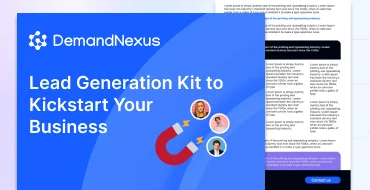Why Intent-Based Marketing Is Gaining Ground
In today’s fast-paced digital landscape, competition is fierce—and businesses are feeling the heat to make every marketing dollar stretch further. Traditional campaign planning just doesn’t cut it anymore when consumer expectations shift at lightning speed. That’s where intent-based marketing comes into play. This modern approach is quickly becoming a favorite because it helps brands better understand their audience and deliver highly relevant messages in real time—resulting in stronger engagement and higher revenue.
But intent-based marketing isn’t just another passing trend—it marks a major shift in how companies connect with potential customers. Instead of focusing on static traits like age or location, this strategy looks at what people are actually doing online right now. That means more relevant content, smarter targeting, and ultimately, better results.
What Is Intent-Based Marketing?
Intent-based marketing revolves around analyzing user behavior online—things like search terms, page visits, or time spent on specific content—to identify buying signals. These insights help marketers figure out where someone might be in their purchasing journey.
Unlike demographic targeting that relies on who your customer is on paper (like age or region), intent data shows you what they’re actively interested in at any given moment. This allows for timely messaging that feels much more personal—and effective.
With intent-based marketing, you can:
- Spot high-value leads who are already showing interest
- Customize messaging based on where users are in the buyer journey
- Spend your advertising budget more wisely by focusing only where there’s clear demand
Understanding Active vs Passive Intent
Not all intent signals carry the same weight—they generally fall into two categories:
- Active Intent: Happens when someone shows direct interest in a product or service—for example, searching “best laptops under $1,000” or comparing product features online. These users are close to making a purchase decision.
- Passive Intent: Broader and less urgent—a person might be browsing “home office ideas” or reading about tech upgrades without any immediate buying plans. They’re still early in their research phase but could become valuable prospects later with the right nurturing.
Recognizing which type of signal you’re working with lets you fine-tune your messaging accordingly—offering educational resources for passive browsers while delivering strong calls-to-action for active buyers ready to convert.
Why Now? The Importance of Intent Data Today
Customers today expect brands to know them—not just by name but by need. According to Statista, over 70% expect personalized offers when they visit websites; meanwhile, 62% say they’ll drop brands that don’t meet those expectations.
Intent data bridges this gap beautifully because it aligns communication with actual user behavior—as it’s happening—instead of relying solely on assumptions from past actions or demographics.
Key Benefits of Intent-Based Strategies
| Benefit | Description |
|---|---|
| Higher ROI from Your Ad Spend | Rather than casting a wide net hoping something sticks, you can zero-in on people who’ve already expressed interest—cutting waste and boosting conversions. |
| Improved Personalization | When you know exactly what someone’s looking for—or even thinking about—you can serve up content that speaks directly to them, whether they’re new visitors or loyal customers returning for more. |
| Smoother Customer Journeys | By offering relevant information at each stage—from discovery through decision—you keep prospects engaged without overwhelming them. |
| Smarter Budget Allocation | Intent signals help prioritize which leads deserve attention right now, so teams don’t waste effort chasing cold prospects. |
| Better SEO Results | Behavioral insights also inform content creation strategies; knowing what topics resonate most helps improve organic rankings while attracting qualified traffic. |
Real-World Uses: How Brands Apply Intent Data Every Day
- Targeted Digital Ads: Platforms like Google Ads let advertisers serve customized ads based on recent searches or website visits—for example, showing e-bike deals after someone browses electric bikes elsewhere online.
- Personalized Website Experiences: Websites dynamically adjust depending on user behavior—a travel site may highlight beach resorts if you’re exploring tropical getaways while promoting ski packages if winter destinations seem more your style.
- Email Campaigns & Social Media Posts: If someone abandons their cart mid-purchase, send an automated email reminder—with maybe even an exclusive discount code thrown in. Social platforms also use browsing history cues to display sponsored posts likely aligned with current interests.
- Retargeting Campaigns That Work Smarter, Not Harder: Retargeting brings back potential buyers who didn’t convert initially—think follow-up ads featuring glowing reviews after viewing (but not purchasing) a product page.
How to Build an Effective Strategy Using User Intent
- Outline Your Buyer Journey: Clearly break down stages like awareness → interest → consideration → evaluation → decision. Match common behaviors (like searches) with each one so you’ll recognize exactly where users stand.
- Segment Based on Behavior: Use CRM tools + lead scoring systems to group people according to actions—not guesses. This makes outreach far more focused—and effective too!
- Match Content with Each Stage:
- Top-of-Funnel Content: Educational blog posts, how-to videos, explainer articles
- Mid-Funnel Assets: Whitepapers, case studies, comparison guides
- Bottom-of-Funnel Offers: Product demos, pricing info, testimonials
- Evaluate What Competitors Are Doing: Check out how others engage audiences across different stages—but aim higher! Use gaps + weaknesses as opportunities for differentiation fueled by fresh insights from your own audience’s activity patterns.
- Keep Improving Through Testing & Analysis: Behavior changes constantly—which means ongoing optimization is key. Track performance metrics closely; A/B test offers regularly; refine segmentation as new trends emerge.
Tools That Help Make It Happen
- CRM Platforms: Help organize contacts by behavior-driven segments so communications feel personal rather than generic.
- Marketing Automation Systems: Trigger sequences automatically based off user activity, such as opening emails or clicking links.
- Ad Networks: Serve dynamic ad creatives tailored specifically around recent interactions.
- Analytics Platforms: Monitor engagement levels across touchpoints so nothing falls through unnoticed.
Mailchimp’s automation features offer great examples—it lets businesses create full customer journeys triggered entirely by real-time activity, including personalized emails using first names & prior purchases.
Potential Challenges to Watch Out For
- Data Accuracy Matters Most: Poor-quality info leads straight toward misfires—not smart campaigns. Stick with verified sources wherever possible.
- Integration Can Be Tricky: Merging behavioral data into existing CRMs isn’t always straightforward—but unified platforms simplify things significantly.
- Respect Privacy Regulations: Transparency counts big here! Always disclose usage policies clearly + stay compliant under rules such as GDPR/CCPA.
- Technology Isn’t Always Cheap: Advanced personalization tools often come at a cost—but returns typically justify investment once implemented correctly.
Final Thoughts on Making It Work Long-Term
At its heart, intention-driven marketing helps brands speak directly—and meaningfully—to customers wherever they happen along their journey, both mentally and digitally alike!
Whether you’re running lean as a startup—or scaling fast inside an enterprise—the ability to act swiftly using real-time behavioral cues gives a serious edge over competitors stuck relying solely upon outdated methods alone.
Ready to Take Action?



